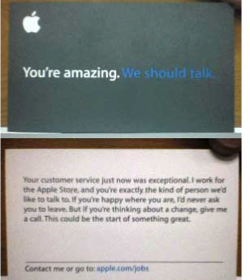
Want to impress your CEO? Few CEOs wouldn’t mind having the innovation track record of Apple, so there is probably no quicker way to become an “instant hero” then by learning how Apple’s talent management practices have contributed to its success and applying those practices relevant to your organization. In this installment of the case study, we’ll look at internal branding, employer branding, and recruiting.
Internal Brand Encourages Fighting the Status Quo
Steve Jobs and the management team at Apple have worked tirelessly to build a unique internal brand image at Apple that positions employees (at least mentally) as revolutionaries and rebels. Many years ago the organization influenced this internal brand by challenging employees to think how much more exciting it would be to be a pirate, rather than someone who followed the formal protocol of the regular Navy. It even flew a pirate flag over its corporate headquarters. The tradition of being revolutionaries is upheld even today with many supportive slogans including “Part career, part revolution.”
Apple is well known for using T-shirts, parties, and celebrations to build cohesion and to reinforce the internal brand as a ragtag group of revolutionaries. By getting employees to view their role as attacking the status quo, it helps to spur continuous and disruptive innovation. It has been successful in maintaining that internal brand image despite the fact that the top-down approach and intense secrecy run counter to its hatred of bureaucracy and all things “too corporate.” The external image further supports the internal brand.
You Can Have a Strong External Employer Brand Without an Employer Branding Program
Many among us dream of working at Apple, but unlike Google and Facebook, it’s pretty difficult to find out what it’s actually like to work there. A quick search on the Internet reveals that apart from a few alumni, most who have roamed the halls are pretty tight-lipped about their experience. While that silence is probably largely driven by Apple’s widespread use and vigilantly enforced non-disclosure agreements, even the corporation itself is relatively mum. You won’t find a great deal of employment advertising or find the Apple name on any one of a dozen or more best-company-to-work-for lists covering the technology sector, even though competitors like Google, Microsoft, and Intel are regularly listed.
Despite the silence, most would agree that Apple has a great “employer brand image”; Universum ranks Apple No. 10 among global engineering companies. The lesson to be learned is simple: use management practices that support your desired brand and elaborate brand management work will be unnecessary. Get your potential applicants to admire your firm for who and what the firm does by being the admirable firm.
Your Product Brand Should Serve Double-duty as Your Employer Brand
Instead of spending millions on building an employer brand, Apple lets its product brand do all the talking. Apple works hard on building and maintaining its product brand, which is ranked as the #1 global brand according to BrandZ ranking. Although product brand messages are intended primarily for customers, the messaging which emphasizes innovation and thinking differently also hasa major impact on potential applicants and employees. The logic is that if your organization lives up to its product promises, then it is natural to expect that the company’s jobs would also live up to the firm’s brand promise. In their minds, potential applicants make the connection between great products and a great place to work. In addition, because Apple’s products are talked about by everyone, there is a lot of brand association power lauded on those who work at Apple.
This public awareness and admiration can, coupled with a strong employee referral program, make generating a high volume of quality applicants easy. That same attention and curiosity will also enhance a firm’s retention rates because your employees will realize that the public sees them as collectively changing the world. Having employees believe that they are likely doing “the best work of their lives” is a powerful situation that most companies can’t easily mimic.
Being a Most-admired Firm May Be Enough
Apple does receive some notoriety in the press as the world’s “most admired firm.” In fact, Apple has been No. 1 for four years running on the list. That is an amazing feat. Apple dominates this list by being ranked first in eight out of the nine possible ranking factors. Those eight categories include factors that impress potential applicants, including people management, quality of management team, innovativeness, and social responsibility. The most admired list is based on the perceptions of business people and executives, something that Apple excels at managing. Having your firm admired garners enormous publicity in addition to increasing employee pride, engagement, and retention. The lesson to be learned by other firms is that if you don’t offer great benefits (which Apple doesn’t) you can get the same or even larger impact if you manage the perceptions of executives at other firms.
We want our people to be on the leading edge, so that everyone wants them… and then we must treat them right so they will stay, no matter what offers come along! —Apple Senior Manager
Aggressively Recruit the Best From Other Firms
The pirate-raiding mentality at Apple certainly carries over into recruiting. Apple has a long history of recruiting away top talent from other firms. In fact, the development of its iPod probably wouldn’t have occurred if it wasn’t for importing external talent from firms that didn’t appreciate the value of this new technology. Steve Jobs himself has been known to get directly involved in recruiting top talent. Apple has a top-grading type philosophy in that it targets top performers. Jay Elliot, its former VP of HR, cites one of Apple’s core principles as: “Always… hire the best ‘A’ people. As soon as you hire a B, they start bringing in Bs and Cs.”
Apple’s recruiting approach is evolving because it has recently imported a team of recruiting leaders from Electronic Arts, but historically, despite the aggressive philosophy, its recruiting methods were pedestrian. It uses job boards and has an employee referral program that has paid up to $5,000, but its candidate experience is far from perfect. Glassdoor users rate Apple interviews 3.0/5.0 with regard to difficulty. Its college recruiting effort isn’t exceptional, with the exception of using recent college hires to help recruit the new crop. The key lesson for other firms to learn is that you can generate huge volumes of high-quality applicants if your firm is highly admired and if potential employees believe that they will be working on leading-edge products that everyone will be talking about.
 In the retail group, there are two notable recruiting practices. The first has been the naming of the “Genius Bar,” where technical support is provided. Many applicants and employees in the retail area seem to be willing to put up with the relative drudgery of retail work simply for the opportunity to someday work their way up to becoming certified as a “genius.” The second is the use of employee referral cards that are well-designed and powerful. They reinforce the companywide focus that originated with Steve Jobs on recruiting the best from other firms. Recruiters and employees who witness great customer service at other retail and customer service outlets hand the card to those few individuals who provide impressive service. The front of the referral cards say “You’re amazing. We should talk.”
In the retail group, there are two notable recruiting practices. The first has been the naming of the “Genius Bar,” where technical support is provided. Many applicants and employees in the retail area seem to be willing to put up with the relative drudgery of retail work simply for the opportunity to someday work their way up to becoming certified as a “genius.” The second is the use of employee referral cards that are well-designed and powerful. They reinforce the companywide focus that originated with Steve Jobs on recruiting the best from other firms. Recruiters and employees who witness great customer service at other retail and customer service outlets hand the card to those few individuals who provide impressive service. The front of the referral cards say “You’re amazing. We should talk.”
The back praises the individual and their work with a near perfect narrative … “Your customer service just now was exceptional. I work for the Apple store and you’re exactly the kind of person we’d like to talk to. If you’re happy where you are, I’d never ask you to leave. But if you’re thinking about a change, give me a call. This could be the start of something great.”
Next week, Part 4: Apple’s approach to training and development, management, leadership, and other difficult-to-categorize talent management lessons to learn from.